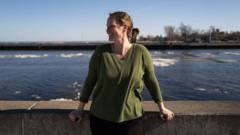More than 150,000 people were forced to evacuate due to the recent fires in Los Angeles, a stark reminder of the escalating climate crisis affecting California. Among those displaced is Christina Welch, who recalls the traumatic experience of the Tubbs fire in 2017, which nearly destroyed her home in Santa Rosa. After suffering through multiple evacuation ordeals, Welch and others are relocating to areas perceived as 'climate havens.' This trend has gained traction in recent years, particularly following devastating wildfire seasons.
Despite recent catastrophic wildfires, experts claim there hasn't yet been a mass exodus linked directly to climate change, although California's population growth rates have seen declines since 2000. Notably, more severe climate events may lead to an increased number of residents seeking new environments. A demographic shift may bring challenges for relatively unprepared cities that could be tasked with accommodating these newcomers.
Cities like Duluth, Minnesota, have garnered attention for their potential as climate havens. Water resources from the nearby Great Lakes and the area's environmental stability are significant draws for those fleeing climate disasters in California. Residents like Jamie Beck Alexander sought refuge from worsening wildfire seasons, discovering a vibrant community that feels reminiscent of their former San Francisco life.
However, the sudden influx of climate migrants presents logistical challenges. Cities like Duluth must develop resources and plans to support potential demographic changes driven by climate factors. Currently, the housing market is feeling the strain from rising demand. Experts caution that adequate infrastructure must be established to handle increases in population stemming from climate-driven relocations.
Similarly, alternative climate havens, such as Asheville, North Carolina, have faced their own climate-related disasters despite attracting migrants seeking safety from issues like wildfires and mudslides. Kelsey Lahr, who relocated to Asheville only to be confronted with the aftermath of Hurricane Helene, realized that no geographical area is free from climate vulnerabilities.
Both Lahr and Alexander emphasize the need to address the fundamental causes of climate change rather than seeking out 'safe' locations, acknowledging that the issue is widespread and inescapable. They illustrate a collective recognition that moving to different regions may not shield them from the ever-present reality of climate change, prompting important discussions about climate resilience and adaptation on a broader scale.
Despite recent catastrophic wildfires, experts claim there hasn't yet been a mass exodus linked directly to climate change, although California's population growth rates have seen declines since 2000. Notably, more severe climate events may lead to an increased number of residents seeking new environments. A demographic shift may bring challenges for relatively unprepared cities that could be tasked with accommodating these newcomers.
Cities like Duluth, Minnesota, have garnered attention for their potential as climate havens. Water resources from the nearby Great Lakes and the area's environmental stability are significant draws for those fleeing climate disasters in California. Residents like Jamie Beck Alexander sought refuge from worsening wildfire seasons, discovering a vibrant community that feels reminiscent of their former San Francisco life.
However, the sudden influx of climate migrants presents logistical challenges. Cities like Duluth must develop resources and plans to support potential demographic changes driven by climate factors. Currently, the housing market is feeling the strain from rising demand. Experts caution that adequate infrastructure must be established to handle increases in population stemming from climate-driven relocations.
Similarly, alternative climate havens, such as Asheville, North Carolina, have faced their own climate-related disasters despite attracting migrants seeking safety from issues like wildfires and mudslides. Kelsey Lahr, who relocated to Asheville only to be confronted with the aftermath of Hurricane Helene, realized that no geographical area is free from climate vulnerabilities.
Both Lahr and Alexander emphasize the need to address the fundamental causes of climate change rather than seeking out 'safe' locations, acknowledging that the issue is widespread and inescapable. They illustrate a collective recognition that moving to different regions may not shield them from the ever-present reality of climate change, prompting important discussions about climate resilience and adaptation on a broader scale.



















